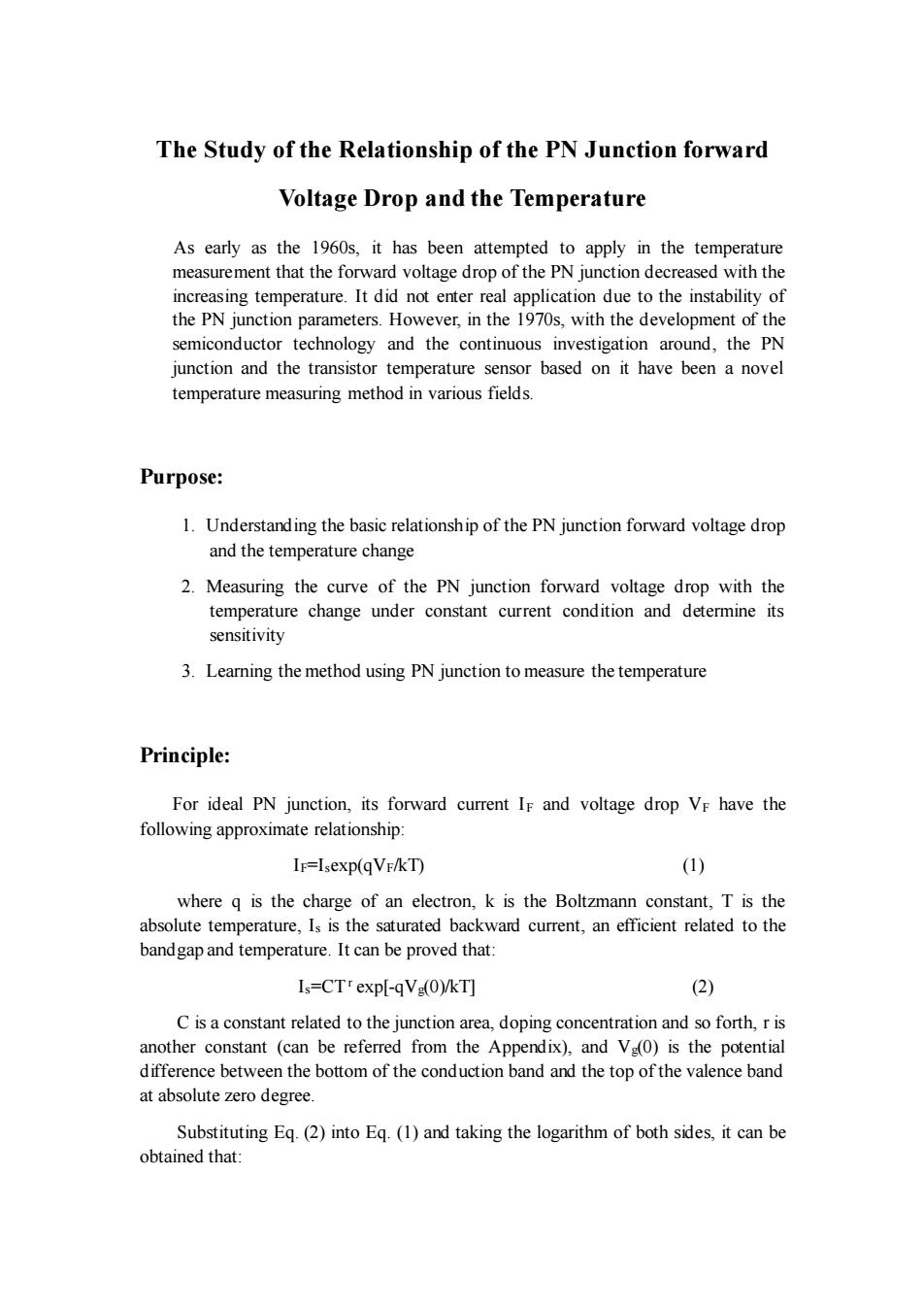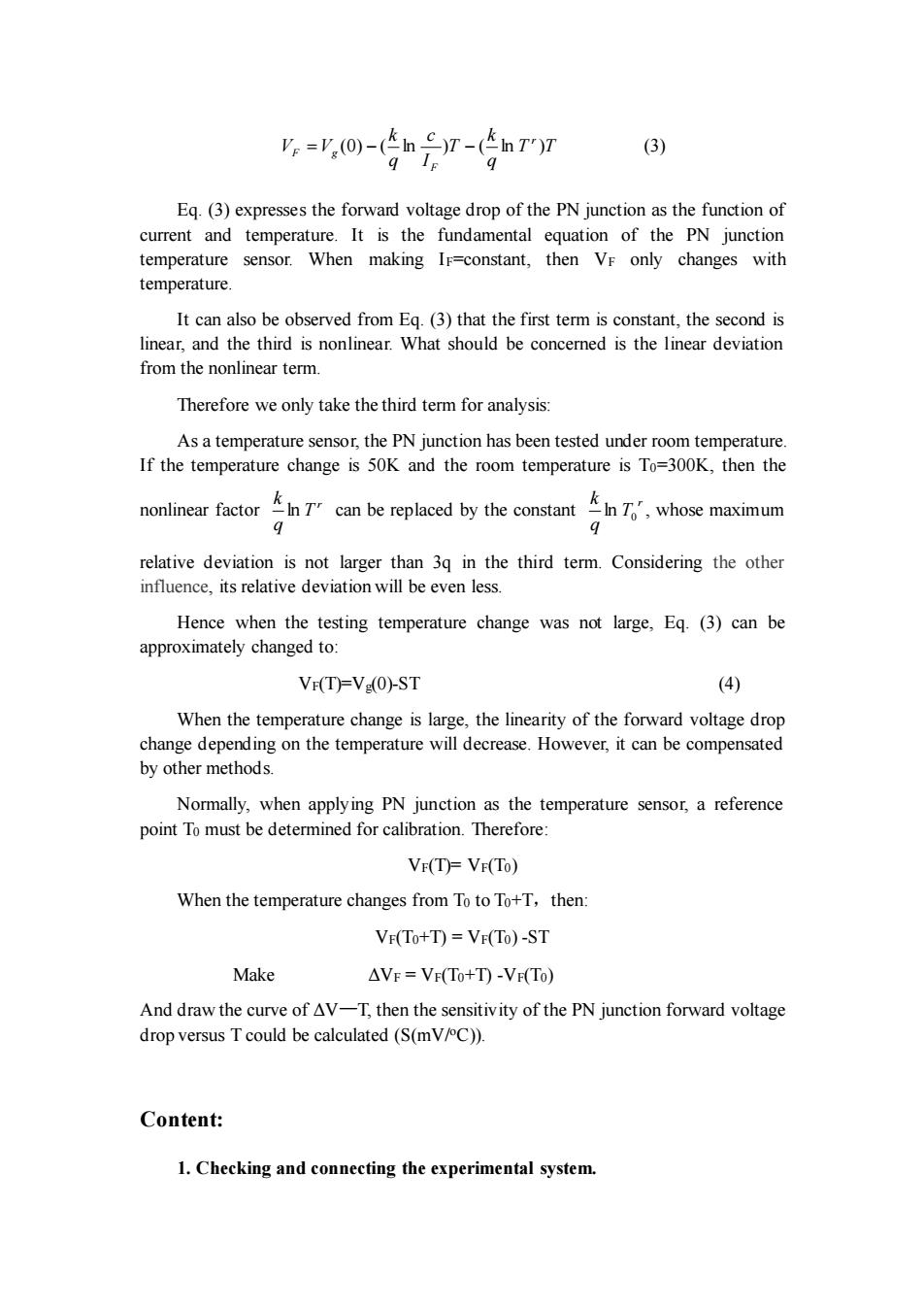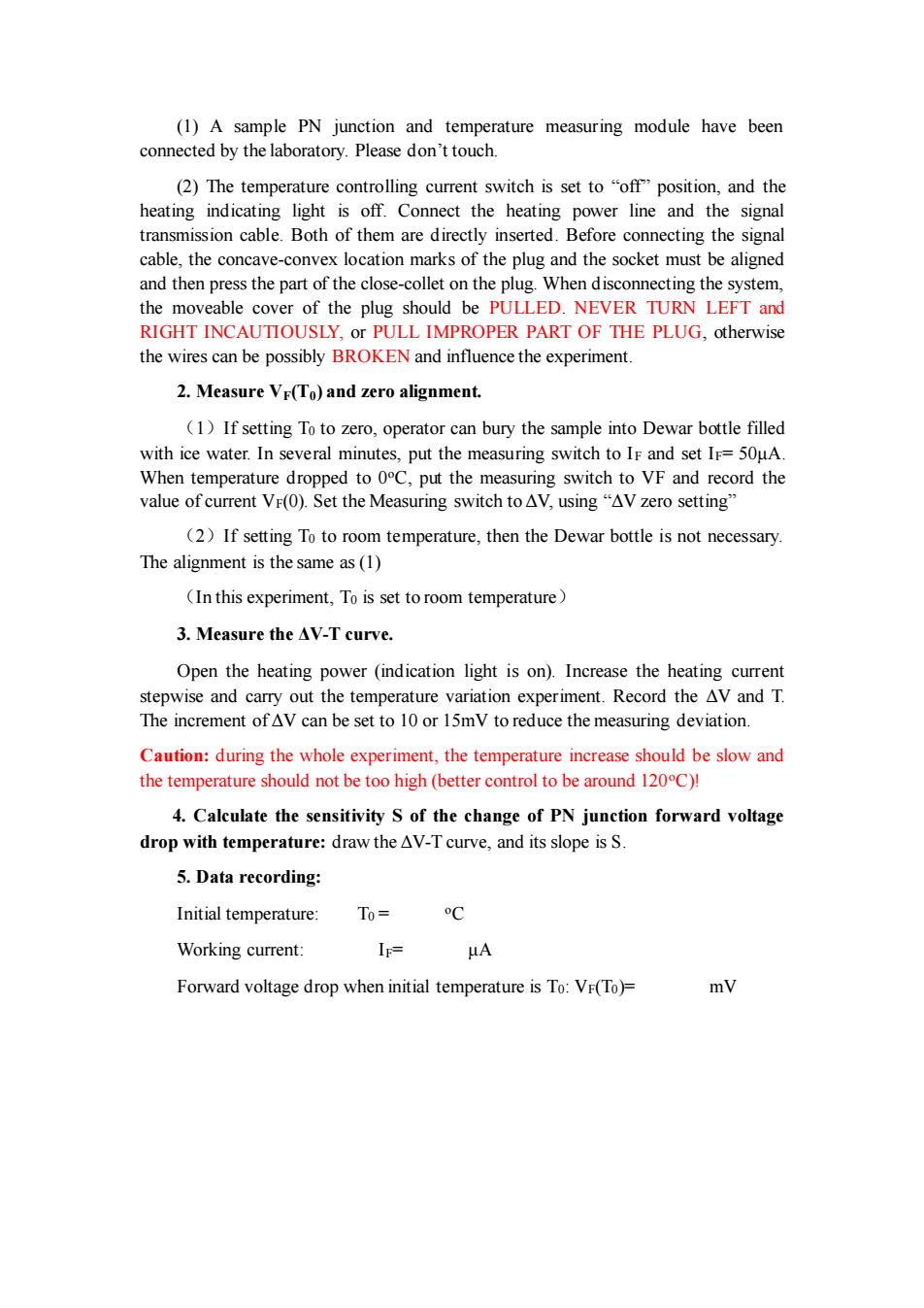
The Study of the Relationship of the PN Junction forward Voltage Drop and the Temperature As early as the 1960s,it has been attempted to apply in the temperature measurement that the forward voltage drop of the PN junction decreased with the increasing temperature.It did not enter real application due to the instability of the PN junction parameters.However,in the 1970s,with the development of the semiconductor technology and the continuous investigation around,the PN junction and the transistor temperature sensor based on it have been a novel temperature measuring method in various fields. Purpose: 1.Understanding the basic relationship of the PN junction forward voltage drop and the temperature change 2.Measuring the curve of the PN junction forward voltage drop with the temperature change under constant current condition and determine its sensitivity 3.Learning the method using PN junction to measure the temperature Principle: For ideal PN junction,its forward current IF and voltage drop VF have the following approximate relationship: IF=Isexp(qVF/kT) (1) where q is the charge of an electron,k is the Boltzmann constant,T is the absolute temperature,Is is the saturated backward current,an efficient related to the bandgap and temperature.It can be proved that: Is=CTr exp[-qVg(0)/kT] (2) C is a constant related to the junction area,doping concentration and so forth,r is another constant (can be referred from the Appendix),and Vg(0)is the potential difference between the bottom of the conduction band and the top of the valence band at absolute zero degree. Substituting Eq.(2)into Eq.(1)and taking the logarithm of both sides,it can be obtained that:
The Study of the Relationship of the PN Junction forward Voltage Drop and the Temperature As early as the 1960s, it has been attempted to apply in the temperature measurement that the forward voltage drop of the PN junction decreased with the increasing temperature. It did not enter real application due to the instability of the PN junction parameters. However, in the 1970s, with the development of the semiconductor technology and the continuous investigation around, the PN junction and the transistor temperature sensor based on it have been a novel temperature measuring method in various fields. Purpose: 1. Understanding the basic relationship of the PN junction forward voltage drop and the temperature change 2. Measuring the curve of the PN junction forward voltage drop with the temperature change under constant current condition and determine its sensitivity 3. Learning the method using PN junction to measure the temperature Principle: For ideal PN junction, its forward current IF and voltage drop VF have the following approximate relationship: IF=Isexp(qVF/kT) (1) where q is the charge of an electron, k is the Boltzmann constant, T is the absolute temperature, Is is the saturated backward current, an efficient related to the bandgap and temperature. It can be proved that: Is=CTr exp[-qVg(0)/kT] (2) C is a constant related to the junction area, doping concentration and so forth, r is another constant (can be referred from the Appendix), and Vg(0) is the potential difference between the bottom of the conduction band and the top of the valence band at absolute zero degree. Substituting Eq. (2) into Eq. (1) and taking the logarithm of both sides, it can be obtained that:

V,=yeo)-(色nSr-(hTrT (3) Eq.(3)expresses the forward voltage drop of the PN junction as the function of current and temperature.It is the fundamental equation of the PN junction temperature sensor.When making IF=constant,then Vr only changes with temperature. It can also be observed from Eq.(3)that the first term is constant,the second is linear,and the third is nonlinear.What should be concerned is the linear deviation from the nonlinear term. Therefore we only take the third term for analysis: As a temperature sensor,the PN junction has been tested under room temperature. If the temperature change is 50K and the room temperature is To=300K,then the nonlinear factorcan be replaced by the constantwhose maximum relative deviation is not larger than 3q in the third term.Considering the other influence,its relative deviation will be even less. Hence when the testing temperature change was not large,Eq.(3)can be approximately changed to: VF(T)=Vg(0)-ST (4) When the temperature change is large,the linearity of the forward voltage drop change depending on the temperature will decrease.However,it can be compensated by other methods. Normally,when applying PN junction as the temperature sensor,a reference point To must be determined for calibration.Therefore: VF(T)=VF(To) When the temperature changes from Toto To+T,then: VF(To+T)=VF(To)-ST Make △VF=Vr(To+T)-Vr(To) And draw the curve of AV-T,then the sensitivity of the PN junction forward voltage drop versus T could be calculated (S(mV/C)). Content: 1.Checking and connecting the experimental system
T T q k T I c q k V V r F F g = (0) − ( ln ) − ( ln ) (3) Eq. (3) expresses the forward voltage drop of the PN junction as the function of current and temperature. It is the fundamental equation of the PN junction temperature sensor. When making IF=constant, then VF only changes with temperature. It can also be observed from Eq. (3) that the first term is constant, the second is linear, and the third is nonlinear. What should be concerned is the linear deviation from the nonlinear term. Therefore we only take the third term for analysis: As a temperature sensor, the PN junction has been tested under room temperature. If the temperature change is 50K and the room temperature is T0=300K, then the nonlinear factor r T q k ln can be replaced by the constant r T q k 0 ln , whose maximum relative deviation is not larger than 3q in the third term. Considering the other influence, its relative deviation will be even less. Hence when the testing temperature change was not large, Eq. (3) can be approximately changed to: VF(T)=Vg(0)-ST (4) When the temperature change is large, the linearity of the forward voltage drop change depending on the temperature will decrease. However, it can be compensated by other methods. Normally, when applying PN junction as the temperature sensor, a reference point T0 must be determined for calibration. Therefore: VF(T)= VF(T0) When the temperature changes from T0 to T0+T,then: VF(T0+T) = VF(T0) -ST Make ΔVF = VF(T0+T) -VF(T0) And draw the curve of ΔV—T, then the sensitivity of the PN junction forward voltage drop versus T could be calculated (S(mV/oC)). Content: 1. Checking and connecting the experimental system

(1)A sample PN junction and temperature measuring module have been connected by the laboratory.Please don't touch. (2)The temperature controlling current switch is set to "off position,and the heating indicating light is off.Connect the heating power line and the signal transmission cable.Both of them are directly inserted.Before connecting the signal cable,the concave-convex location marks of the plug and the socket must be aligned and then press the part of the close-collet on the plug.When disconnecting the system, the moveable cover of the plug should be PULLED.NEVER TURN LEFT and RIGHT INCAUTIOUSLY,or PULL IMPROPER PART OF THE PLUG,otherwise the wires can be possibly BROKEN and influence the experiment. 2.Measure Vr(To)and zero alignment. (1)If setting To to zero,operator can bury the sample into Dewar bottle filled with ice water.In several minutes,put the measuring switch to IF and set IF=50uA. When temperature dropped to 0C,put the measuring switch to VF and record the value of current VF(0).Set the Measuring switch to AV,using "AV zero setting" (2)If setting To to room temperature,then the Dewar bottle is not necessary. The alignment is the same as(1) (In this experiment,To is set to room temperature) 3.Measure the AV-T curve. Open the heating power (indication light is on).Increase the heating current stepwise and carry out the temperature variation experiment.Record the AV and T. The increment of AV can be set to 10 or 15mV to reduce the measuring deviation. Caution:during the whole experiment,the temperature increase should be slow and the temperature should not be too high(better control to be around 120C)! 4.Calculate the sensitivity S of the change of PN junction forward voltage drop with temperature:draw the AV-T curve,and its slope is S. 5.Data recording: Initial temperature: T0= C Working current: IF= uA Forward voltage drop when initial temperature is To:VF(To)= mV
(1) A sample PN junction and temperature measuring module have been connected by the laboratory. Please don’t touch. (2) The temperature controlling current switch is set to “off” position, and the heating indicating light is off. Connect the heating power line and the signal transmission cable. Both of them are directly inserted. Before connecting the signal cable, the concave-convex location marks of the plug and the socket must be aligned and then press the part of the close-collet on the plug. When disconnecting the system, the moveable cover of the plug should be PULLED. NEVER TURN LEFT and RIGHT INCAUTIOUSLY, or PULL IMPROPER PART OF THE PLUG, otherwise the wires can be possibly BROKEN and influence the experiment. 2. Measure VF(T0) and zero alignment. (1)If setting T0 to zero, operator can bury the sample into Dewar bottle filled with ice water. In several minutes, put the measuring switch to I F and set IF= 50μA. When temperature dropped to 0oC, put the measuring switch to VF and record the value of current VF(0). Set the Measuring switch to ΔV, using “ΔV zero setting” (2)If setting T0 to room temperature, then the Dewar bottle is not necessary. The alignment is the same as (1) (In this experiment, T0 is set to room temperature) 3. Measure the ΔV-T curve. Open the heating power (indication light is on). Increase the heating current stepwise and carry out the temperature variation experiment. Record the ΔV and T. The increment of ΔV can be set to 10 or 15mV to reduce the measuring deviation. Caution: during the whole experiment, the temperature increase should be slow and the temperature should not be too high (better control to be around 120oC)! 4. Calculate the sensitivity S of the change of PN junction forward voltage drop with temperature: draw the ΔV-T curve, and its slope is S. 5. Data recording: Initial temperature: T0 = oC Working current: IF= μA Forward voltage drop when initial temperature is T0: VF(T0)= mV